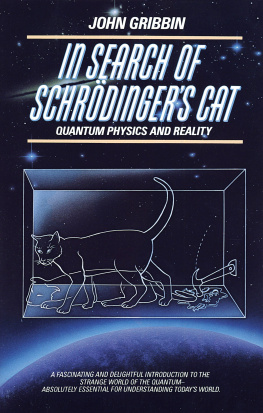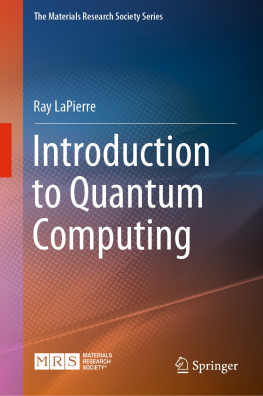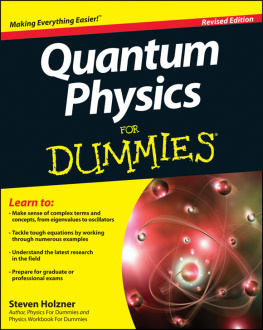Quantum Physics
A Beginners Guide
ONEWORLD BEGINNERS GUIDES combine an original, inventive, and engaging approach with expert analysis on subjects ranging from art and history to religion and politics, and everything in between. Innovative and affordable, books in the series are perfect for anyone curious about the way the world works and the big ideas of our time.
africa | genetics |
anarchism | global terrorism |
aquinas | hinduism |
artificial intelligence | history of science |
the bahai faith | humanism |
the beat generation journalism | islamic philosophy |
biodiversity | journalism |
bioterror & biowarfare lacan | judaism |
the brain | lacan |
british politics | life in the universe |
the buddha | literary theory |
cancer | machiavelli |
censorship | mafia & organized crime |
christianity | magic |
civil liberties | marx |
classical music | medieval philosophy |
climate change | middle east |
cloning | NATO |
cold war | nietzsche |
conservation | the northern ireland conflict |
crimes against humanity opera | oil |
criminal psychology | opera |
critical thinking | the palestineisraeli conflict |
daoism | particle physics |
democracy | paul |
descartes | philosophy of mind |
dyslexia | philosophy of religion |
energy | philosophy of science |
engineering | postmodernism |
the enlightenment | psychology |
epistemology | quantum physics |
evolution | the quran |
evolutionary psychology | racism |
existentialism | renaissance art |
fair trade | shakespeare |
feminism | the small arms trade |
forensic science | sufism |
french revolution | volcanoes |

Quantum Physics
A Beginners Guide
Alastair I. M. Rae

A Oneworld Book
First published by Oneworld Publications 2005
Copyright Alastair I. M. Rae 2005
Reprinted 2006, 2007, 2008, 2009, 2010, 2011
This ebook edition published by Oneworld Publications 2011
All rights reserved
Copyright under Berne Convention
A CIP record for this title is available
from the British Library
ISBN 9781780740478
Typeset by Jayvee, Trivandrum, India
Cover design by Two Associates
Oneworld Publications
185 Banbury Road
Oxford
OX2 7AR
England
Learn more about Oneworld. Join our mailing list to find out about our latest titles and special offers at:
www.oneworld-publications.com
To Amelia and Alex
Preface
The year 2005 is the World Year of Physics. It marks the centenary of the publication of three papers by Albert Einstein during a few months in 1905. The most famous of these is probably the third, which set out the theory of relativity, while the second paper provided definitive evidence for the (then controversial) idea that matter was composed of atoms. Both had a profound effect on the development of physics during the rest of the twentieth century and beyond, but it is Einsteins first paper that led to quantum physics.
In this paper, Einstein showed how some recent experiments demonstrated that the energy in a beam of light travelled in packets known as quanta (singular: quantum), despite the fact that in many situations light is known to behave as a wave. This apparent contradiction was to lead to the idea of waveparticle duality and eventually to the puzzle of Schrdingers famous (or notorious) cat. This book aims to introduce the reader to a selection of the successes and triumphs of quantum physics; some of these lie in explanations of the behaviour of matter on the atomic and smaller scales, but the main focus is on the manifestation of quantum physics in everyday phenomena. It is not always realized that much of our modern technology has an explicitly quantum basis. This applies not only to the inner workings of the silicon chips that power our computers, but also to the fact that electricity can be conducted along metal wires and not through insulators. For many years now, there has been considerable concern about the effect of our technology on the environment and, in particular, how emission of carbon dioxide into the Earths atmosphere is leading to global warming; this greenhouse effect is also a manifestation of quantum physics, as are some of the green technologies being developed to counteract it. These phenomena are discussed here, as are the application of quantum physics to what is known as superconductivity and to information technology. We address some of the more philosophical aspects of the subject towards the end of the book.
Quantum physics has acquired a reputation as a subject of great complexity and difficulty; it is thought to require considerable intellectual effort and, in particular, a mastery of higher mathematics. However, quantum physics need not be rocket science. It is possible to use the idea of waveparticle duality to understand many important quantum phenomena without much, or any, mathematics. Accordingly, the main text contains practically no mathematics, although it is complemented by mathematical boxes that flesh out some of the arguments. These employ only the basic mathematics many readers will have met at school, and the reader can choose to omit them without missing the main strands of the argument. On the other hand, the aim of this book is to lead readers to an understanding of quantum physics, rather than simply impressing them with its sometimes dramatic results. To this end, considerable use is made of diagrams and the reader would be well advised to study these carefully along with the text. Inevitably, technical terms are introduced from time to time and a glossary of these will be found towards the end of the volume. Some readers may already have some expertise in physics and will no doubt notice various simplifications of the arguments they have been used to. Such simplifications are inevitable in a treatment at this level, but I hope and believe that they have not led to the use of any incorrect models or arguments.
I should like to thank my former students and colleagues at the University of Birmingham, where I taught physics for over thirty years, for giving me the opportunity to widen and deepen my knowledge of the subject. Victoria Roddam and others at Oneworld Publications have shown considerable patience, while applying the pressure needed to ensure the manuscript was delivered, if not in time, then not too late. Thanks are also due to Ann and the rest of my family for their patience and tolerance. Finally, I of course take responsibility for any errors and inaccuracies.










